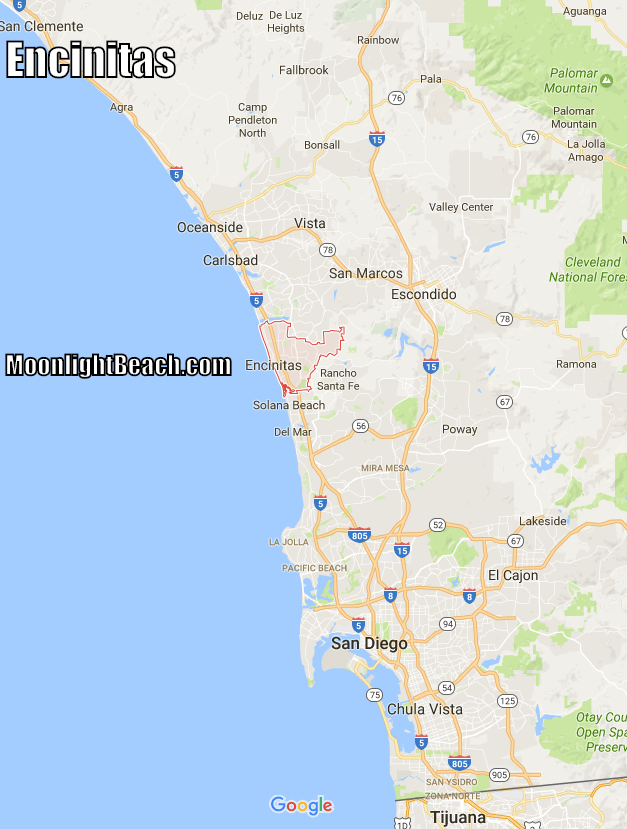At The Edge Of A Continent
At the edge of a continent, along the Southern California coastline, sits a town, Encinitas, that mixes “California Cool” with “California Hip.” When people outside of San Diego County envision a “real” Southern California town, they are seeing Encinitas. With an area of less than 20 square miles, Encinitas is the last hope and sanctuary for many “locals” who remember the avocado farms, funky Leucadia, surfing Swamis all alone and a friendly laid back attitude, dude.
One more quick fact (or two) about Encinitas weather, since you asked… Temperature seldom falls below 40° or exceeds 85°. Average annual high temperature is 72 degrees. Yearly rainfall is 9-11 inches. Yeah, paradise in America.
What Does The City of Encinitas Say?
Located along six miles of Pacific coastline in northern San Diego County, Encinitas has an approximate population of 60,000+ and is characterized by coastal beaches, cliffs, flat-topped coastal areas, steep mesa bluffs and rolling hills. Our city was incorporated in 1986, drawing together the communities of New Encinitas, Old Encinitas, Cardiff-by-the-Sea, Olivenhain and Leucadia.
There is a significant flower growing industry in the City and many people claim that Encinitas is the Flower Growing Capital. As the City has developed, it has grown up around the pre-existing flower growers. Quail Botanical Gardens is a beautiful oasis to visit with an Amazon Rainforest and the largest display of bamboo in the world. The gardens of the Self Realization Center are beautiful and sit overlooking the ocean in a serene garden-like setting.
Thanks to Kylie Reiter for the photo.
Got Golf?
Golf enthusiasts will enjoy our new Encinitas Ranch Golf Course, a championship 18 hole par 72 course with panoramic ocean views. This public facility has five tees available and can be enjoyed by golfers of all abilities.
Got Surf?
The beaches in Encinitas are outstanding. There are many stretches of beach that lie between Cardiff-by-the-Sea and La Costa. The surfing is unbeatable and many surf contests are held throughout the year in Encinitas.
![]() Just how did Beacons get its’ name?
Just how did Beacons get its’ name?
There Is A Downtown?
Downtown 101 is a coastal shopping district over 100 years old featuring historic architecture, quaint shops, sidewalk cafes, and restaurants framed by beautiful flower baskets. The organization Downtown Encinitas Merchants Association (DEMA) is a great resource for information on business in Encinitas.
Even Our Lagoons Are Great!
This place called Encinitas sits on the coastline of the Pacific Ocean and is embraced by the Batiquitos Lagoon to the north and the San Elijo Lagoon to the south. The San Elijo Lagoon Reserve is the largest coastal wetland in San Diego County and is home to nearly 300 different bird species throughout the year.
The Encinitas Chamber of Commerce is an informational site promoting Encinitas. The center directs visitors to local landmarks, restaurants, lodging and provides information on area demographics. Maps, publications, brochures, and souvenirs are available, as well as discounted tickets to Legoland, Wild Animal Park, and the San Diego Zoo.
History of Encinitas
The first inhabitants were Indians called the San Dieguitos, the La Jollans, and the Dieguenos. It was the Diegueno’s group who were mission converts and helped to build the Spanish Missions. In 1669, the Governor of Baja California, Gaspar de Portola, led an expedition throughout the San Diego and Monterey areas. His mission was to build several “presidios,” establishing a teaching base for schools and religion. When the expedition made its way through Encinitas on the El Camino Real, he named the area for the small oak trees on the surrounding hills. He named this area “Encina Canada,” Spanish for “Hills of Live Oaks.” The area changed governmental hands from Spain to Mexico and in the 1800-s the Mexican government issued land grants to ranchers who would establish settlements in the San Diego area and who were willing to be under Mexico’s rule.
In 1881, Jabez Pitcher settled in Encinitas and is considered to be the father of the town. Pitcher came to San Diego and filed a claim for 160 acres on a mesa near the railroad tracks where the Encinitas Civic Center is now located. In 1870, a few miles north of the railroad tracks, English spiritualists named their settlement Leucadia after one of the Greek Isles. The name means “Isle of Paradise” or “Place of Shelter.” The five-acre tracts were named after Greek gods and mythical figures.
The modern history of “Cardiff” began in 1875 when the McKinnon family homesteaded on the north shore of the San Elijo Lagoon. In 1909, J. Frank Cullen bought a large tract in San Elijo, had it surveyed, and established streets and lots. He named his town in 1914, calling it “Cardiff-by-the-Sea,” after Cardiff, Wales. The “Olivenhain” portion of Encinitas was established as a community in 1884 by a small group of German immigrants. The old Olivenhain Meeting Hall is still used today for social events and meetings.
Just What Makes Up Encinitas?
The City of Encinitas is now made up of five communities that take pride in their own distinct personalities. “Historic (Old) Encinitas” fills the Highway 101 Corridor that parallels the beautiful beaches and ocean. “New Encinitas” centers on El Camino Real (“The Kings Highway” founded by the early missionaries from Spain). “Cardiff-by-the-Sea” is made up of quaint homes dotting the hillsides overlooking the sea. “Leucadia” is famous for its giant eucalyptus trees that line the main thoroughfare on the Coast Highway. “Olivenhain” (which means “olive grove” in German) boasts plenty of open horse country, pastures, and a rural way of life.
Hey, We Are A ‘Big City’ Too
Paris has the Eiffel Tower, London has their bridge, but we have the Surfing Madonna…






